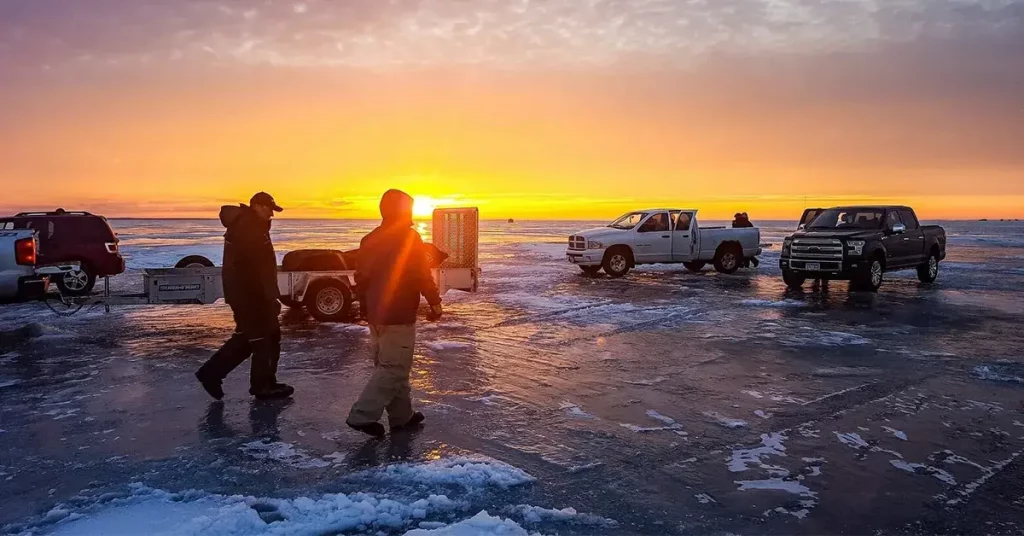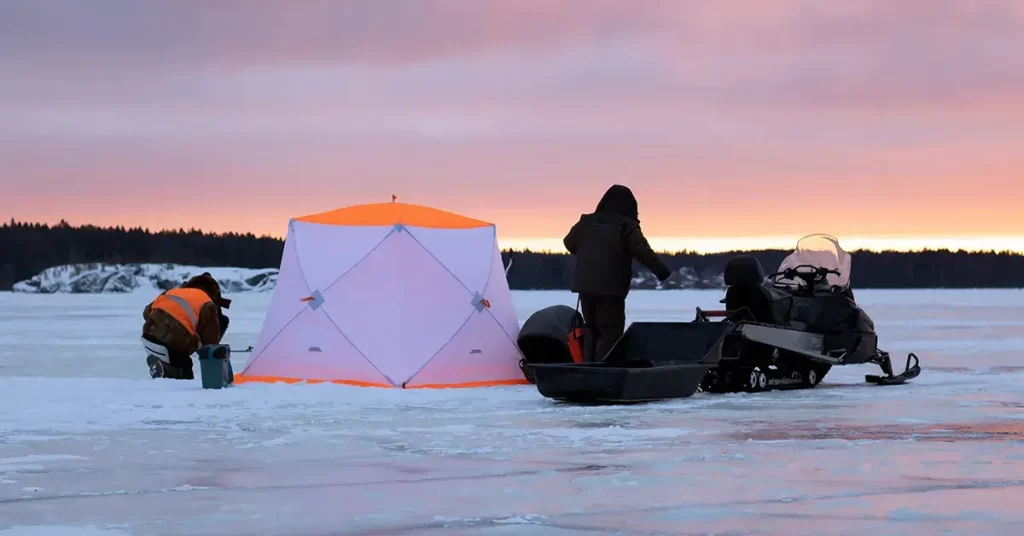Safety should always be your number one priority whenever you’re heading out on the ice. This is especially true in early winter and springtime when the ice is thinner and less structurally sound. While ice fishing is not a particularly dangerous sport – if you neglect to take basic safety precautions, disaster can strike.
One of the most commonly asked questions by curious anglers is “how dangerous is ice fishing?”. The answer to this question involves several factors, including ice thickness and quality, safety precautions taken, and experience.
Let’s take a look at the most important dangers to be aware of, key safety gear and precautions, and what to do if you happen to fall through the ice.
Ice Thickness
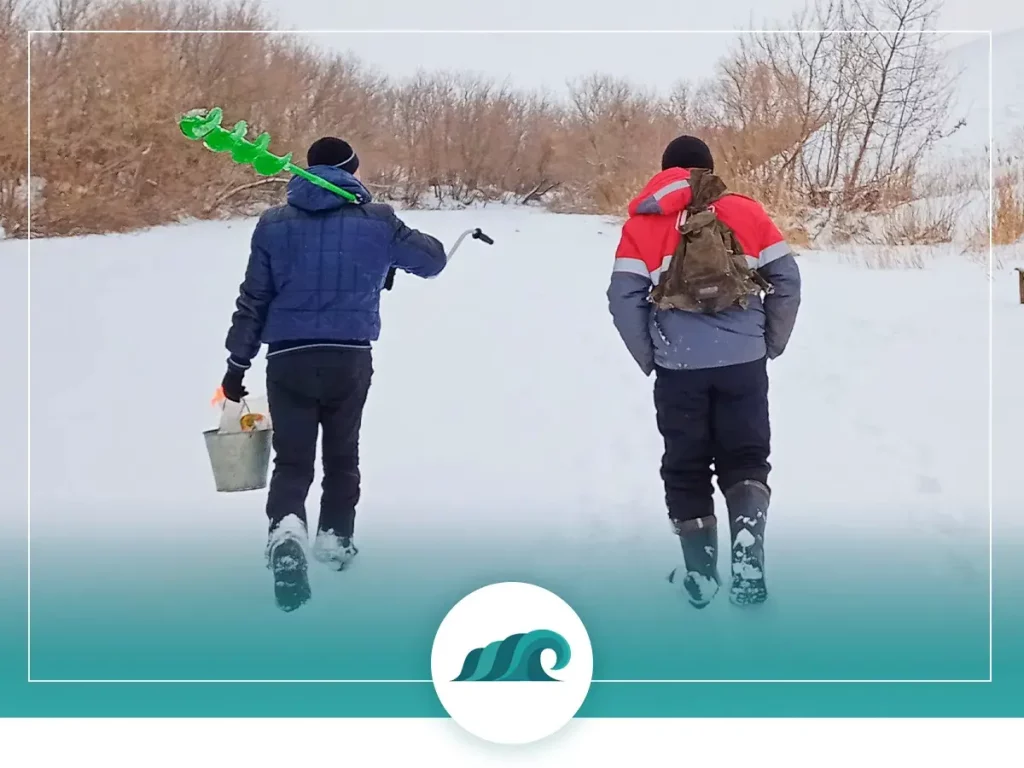
The most important safety factor to be aware of is ice thickness. As a general rule of thumb, ice should be at least 3.5 to 4 inches thick for walking on, 5 inches for snowmobiles and quads, 7 inches for small cars, and 12 inches for pick-up trucks and small vans.
| Walking | 3.5″ to 4″ |
| Snowmobiles and Quads | 5″ |
| Small Cars | 7″ |
| Pick-ups and Small Vans | 12″ |
Keep in mind that ice thickness is generally not uniform throughout an entire body of water. Ice closer to the shore is often thinner than ice further out – due to the heat retained by the ground. Additionally, ice close to fallen logs, large rocks, streams, and strong current is often significantly thinner than ice in ideal conditions.
Checking the ice thickness regularly with a spud bar as you’re walking is a good way to ensure it’s safe to stand on. If you’re new to ice fishing, it’s a good idea to check the ice thickness often, and learn how much force is required to break through the ice when it’s safe/unsafe.
In early winter, and late spring – the ice will often be soft and mushy near the edges – and solid further out. While it’s tempting to hop over the softer ice to get to the harder ice further out, it’s generally not a good idea, and can make your ice fishing outing far more dangerous.
Ice Quality
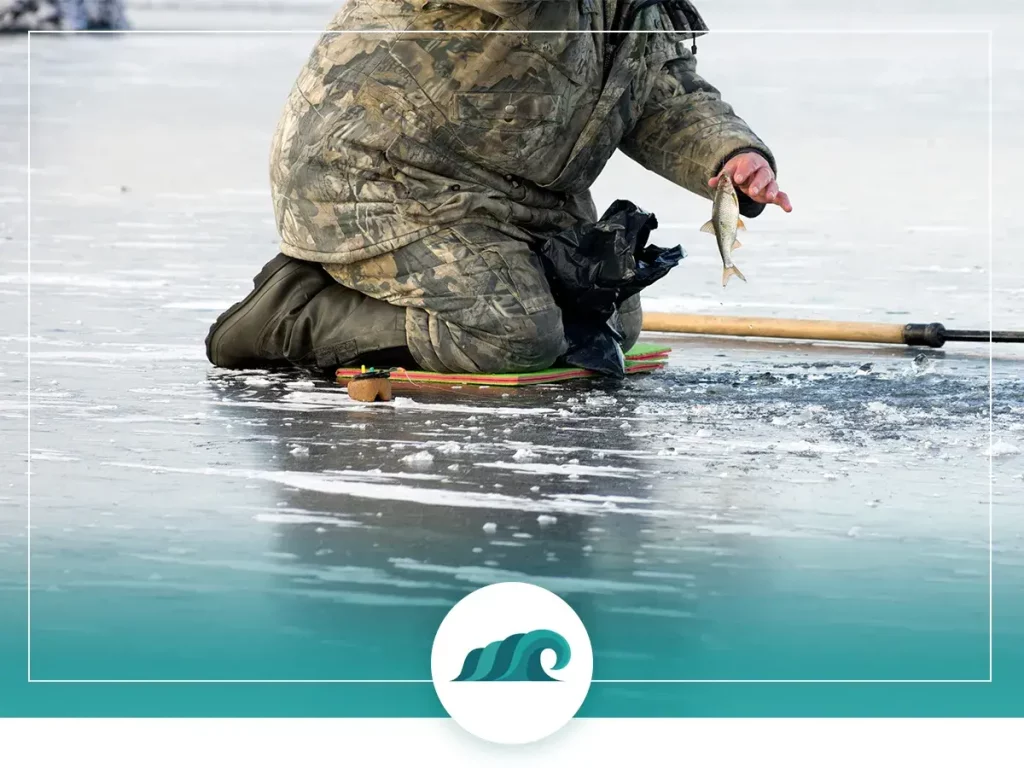
Ice thickness will give you a good indication of its strength, but it’s not the entire story. There are also varying degrees of ice quality – from rock-solid clear ice to watery and dangerous grey ice.
Fresh, clear ice is the strongest and most stable type of ice. It’s formed when temperatures fall below 18° F (-8° C) for three straight weeks. This ice will support ice fishing on foot at 4 inches, and even medium-sized pick-up trucks at 12 inches.
Opaque, white-ish ice is the next strongest type. This ice is formed by fallen snow freezing on top of existing ice. This is generally safe but can be dangerous when it forms over half-frozen ice beneath it. It’s about half as strong as clear ice, so double the above recommendations when you’re on white snow-ice.
Lastly, greyish or “rotten” ice indicates the presence of moving water and is the least safe type. It’s often found in the springtime when ice begins to melt. This type of ice should be avoided, as it’s often unstable and unable to support much weight.
Another thing to keep in mind is that the presence of water on top of the ice can indicate a weak spot, and should be avoided.
Other Dangers
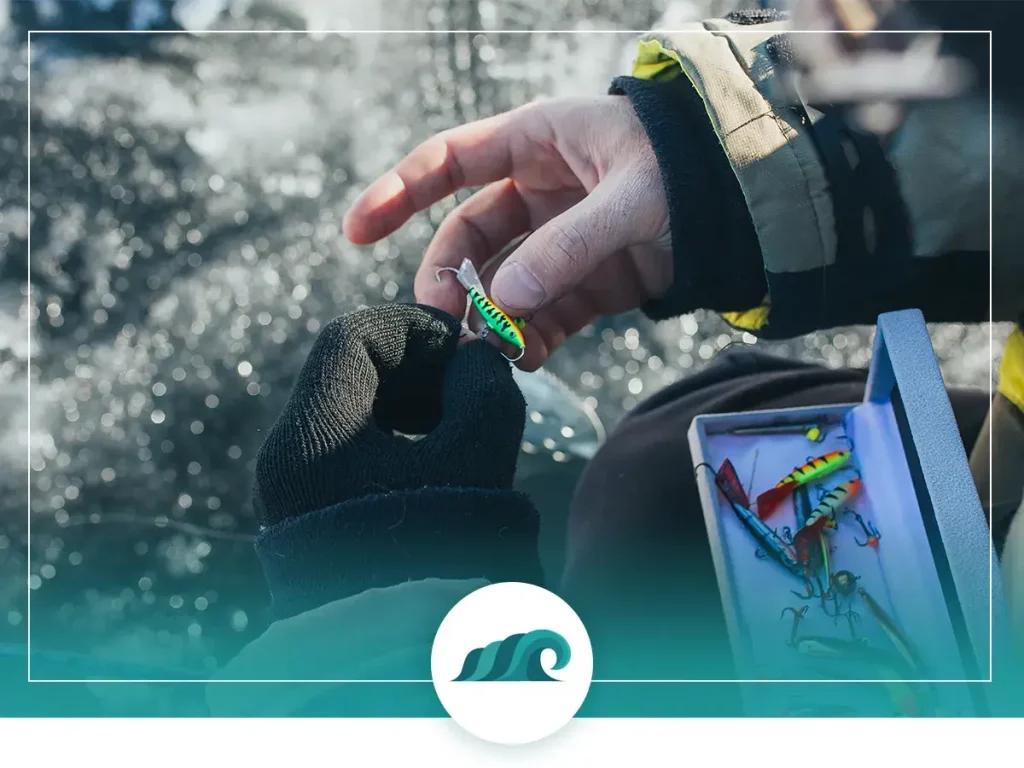
How dangerous is ice fishing then?
When most people think about the dangers involved in ice fishing, falling through the ice is the first thing that comes to mind. While it’s certainly the most feared hazard – it’s far from the most common.
Much more common are injuries from falling on the ice, frostbite, fish hook injuries, and carbon monoxide poisoning from using heaters or augers inside poorly ventilated ice shelters.
Falling on the Ice
Slipping and falling on the ice is by far the most common injury sustained while ice fishing. A hard fall on ice can lead to broken bones, sprains, strains and bruising. A good pair of winter boots combined with ice cleats or “creepers” goes a long way to provide extra traction, and preventing injuries from falling on the ice.
Frostbite
Anytime you’re out in freezing temperatures for prolonged periods, frostbite can become a concern. Frostbite, or “cold thermal injury” is actually a fairly rare occurrence and accounted for only 1.2% of reported ice fishing injuries according to this study.
In any case, it can’t hurt to be prepared, so bundling up in warm clothing and adding thermal layers as needed is a smart move.
Fish Hook Injuries
Fish hook injuries are exceedingly common in all types of fishing, and ice fishing is no exception. Fishing in extreme cold can make your tackle difficult to handle, and result in a hook lodged deep in your arm or even your face! A good pair of gloves and hand warmers can go a long way to increasing your dexterity and preventing fish hook injuries.
Carbon Monoxide/Burns/Fires
While it may not be the first thing that comes to mind when thinking about ice fishing-related injuries, burns, fires, and carbon monoxide poisoning are actually fairly common occurrences.
Many ice fishermen utilize makeshift shelters – and sometimes heat them with poor quality heating systems. These heating systems can lead to burns, fires, and even carbon monoxide poisoning. Combine these rickety shelters with the occasional overconsumption of alcohol while ice fishing, and you’ve got a dangerous recipe for disaster.
Gas and propane-powered augers can also lead to injuries, specifically burns and wrist injuries from carrying a running auger in freezing temperatures.
Safety Gear
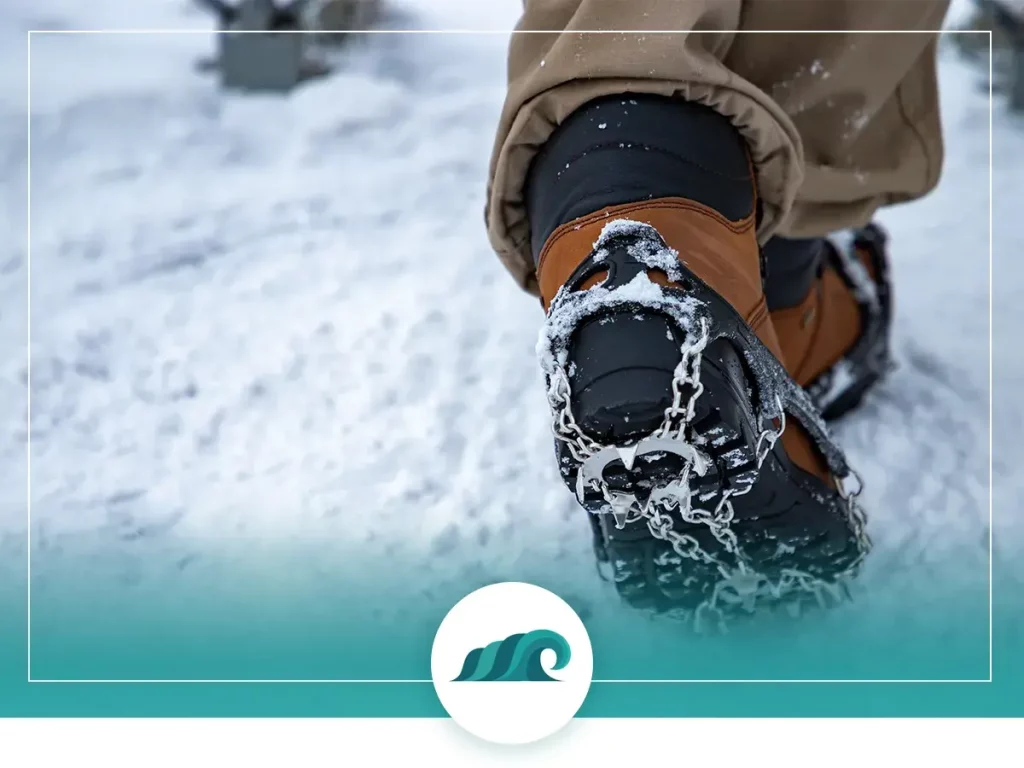
Beyond taking basic safety precautions, there are a few key pieces of safety gear that will greatly increase your safety and chances of surviving a fall through the ice.
Ice Claws
Ice claws (also called safety spikes or ice picks) may be the most important piece of safety gear every ice angler should own. These claws are lightweight, easy to carry on your person, and could save your life one day.
Ice claws come in various designs, but the basic design features two compact plastic handgrips with sharpened ice picks at the ends. The two picks are tethered together with an adjustable rope or cable, which is threaded through the armholes or belt loop of your winter jacket/snowsuit.
In the event you do fall through the ice, ice claws enable you to grip the ice and pull yourself back onto the surface.
Without them, extracting yourself can be extremely difficult – and with freezing water rapidly lowering your body temperature, hypothermia can quickly set in and drowning can occur.
Frabill makes an excellent pair of retractable ice claws. They feature retractable picks – which are easy to store in a pocket or sleeve without worrying about poking yourself with the pick ends.
Spud Bar
As mentioned previously, an ice chisel (also called a spud bar) is a key piece of safety gear. They have a number of uses, from testing the ice thickness, to reopening old holes, to punching new holes through relatively thin ice.
If you’re new to ice fishing, or you’re fishing on relatively thin ice, carrying a spud bar with you can help prevent a dangerous situation. It will allow you to test the ice periodically to ensure its thick enough to support your weight.
Check out my in-depth review of the best ice chisels and spud bars available now.
Throw Rope
A good throw rope comes in handy in many situations – and can be used when performing a rescue on someone who fell through the ice. Another use is for tethering yourself to the shore when initially testing the ice thickness. Stashing one in your vehicle for emergencies is always a good idea.
Cleats
Ice cleats or “creepers” greatly increase your traction on the ice, preventing accidental slips and falls on the ice. These are easy to attach to your winter boots, and are usually fairly inexpensive.
Flotation
Modern ice fishing jackets and bibs often feature built-in flotation technology to keep you afloat in case of a fall through the ice. While ice picks were once the be-all and end-all of ice fishing safety gear, many anglers now believe a flotation suit is even more important.
Consider the situation of sudden fall through the ice, say from a snowmachine or quad.
You may not actually have time to deploy your ice picks. If you submerge before you get a chance to take a breath, your lungs may fill with ice-cold water as you take that initial breathe underwater.
This is how drowning can occur.
With a floatation suit on, your body will stay above water, and you’ll be able to perform a self-rescue or receive assistance from other anglers.
Flotation suits also excel in situations where ice picks alone are less effective. If the ice near the edge is weak and continues to break as you attempt to crawl onto it, you can quickly tire yourself out. A floatation suit will keep your head above water no matter how tired you are, so there’s no chance of drowning as you perform a self-rescue.
Many people are under the impression that hypothermia sets in almost immediately after falling in ice-cold water. The reality is that it can take up to an hour for hypothermia to actually kill you, which means you’ll generally have enough time to extract yourself from the water and warm up.
Striker makes some of the best jackets and bibs with built-in floatation. These jackets are designed specifically with ice fishermen in mind and feature excellent cold weather protection, waterproofing, and breathability as well as flotation.
If you’re interested in ice fishing attire, check out my in-depth look at what to wear when ice fishing.
Auger Blade Cover
Whether you use a simple hand auger or a cutting edge lithium-ion electric auger, a good blade cover will keep your blade from accidentally cutting your other gear (or yourself)! Most augers will come with some form of basic blade cover, which often isn’t the most durable. Picking up a durable aftermarket cover makes sense in that case.
Measurement Device
We all know fishermen like to exaggerate, but when it comes to measuring ice thickness, being precise is the way to go. Many ice fishing scoops come with a ruler imprinted on their side, otherwise, a folding ruler or a simple measuring tape will work well.
What To Do if You Fall Through The Ice?
In the event that you actually fall through the ice, there are a few things to be aware of to ensure you have the best chances for survival.
When you initially plunge into the ice-cold water, your body will go into cold shock and begin to hyperventilate in response to the rapid increase in heart-rate. Try your best to control this urge and slow your breathing down to a controlled pace as quickly as possible. It’s important to resist the urge to panic and flail around wildly – you want to conserve energy and get your body under control as quickly as possible.
After the initial cold shock has worn off (this typically takes around 1 to 3 minutes), you can begin to self-rescue. Assuming you don’t have ice picks on you (get some!), the steps are listed below.
Self Rescue Step-by-Step
- Remove any heavy objects that will weigh you down and make it difficult to pull yourself out of the water (backpack, other gear).
- Orient yourself in the same direction as you fell in. If the ice was sturdy enough to support you before, it’s likely to support your weight again.
- Get your forearms and as much of your upper body onto the ice as possible by shimmying and kicking with your legs. Don’t attempt to pull yourself out of the water straight up, try and stay as horizontal as possible.
- Use your legs to kick as hard as possible to slide your body onto the ice – much like artic seals do.
- Once you’re out of the water, don’t stand up and walk right away – roll away from the hole until your sure you’re back on solid ice.
- Find warm, dry shelter immediately. Even though your out of the water, your still not out of danger – the risk of hypothermia setting in is still high.
If you do have ice picks with you, the steps are essentially the same, but extracting yourself will be much easier to do, as you can drive your picks into the ice and maintain a solid grip on the ice surface.
Check out this in-depth video of a rescue working performing both types of self-rescue, as well as being rescued by bystanders:
Hopefully, you now have a better understanding of ice fishing safety – and the next time someone asks “How dangerous is ice fishing?”, you’ll be well equipped to answer them.

